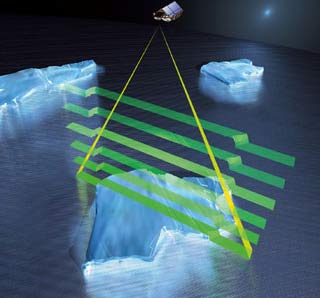Arctic ice melted faster than expected
Increasing global temperatures are leading to the melting of northern European ice faster than expected, while the Groenland ice sheet is in danger of disappearing, according to the latest satellite images.

Mark Drinkwater's analytical model
(Photo: esa.int)
Images from the satellite released on September 20, 2006 from the European Space Agency (ESA) show a sudden split of the ice cap from northern Europe to the North Pole, at the end of this summer.
'This is completely unexpected with what we have observed before,' said Mark Drinkwater, who is in charge of analyzing images of the ESA Earth Observation Center based in Italy. ' A ship can go north from the Spitzberg Islands (Norway) or from North Siberia, through cracks from ice sheets, ' he added.
The images were obtained from August 23-25, 2006, showing a large area of cracked ice from the Spitzberg Islands, the northernmost Norway and the Severnaya Zemlya Islands, Siberia until the North Pole.
The arc of the Arctic ice has shrunk because of the warming of the climate. At the end of the summer of 2005, it was only 5.5 million km 2 , compared with 8 million km 2 in the early 1980s.
Meanwhile, the Groenland ice sheets, the world's second freshwater reserve, lost 2.5 times faster than two years ago, according to NASA satellite images. During the period from May 2004 to April 2006, there were 248 cubic kilometers of ice melted each year, which led to a sea level rise of 0.5 mm / year.
EXPERIENCE
- Ice melts, the sea is wide and the Arctic is in danger
- The Arctic ice melted four times faster than forecast
- Ice melted faster than expected throughout the Earth
- The Arctic lost three times as much ice as Belgium every day
- Ice in the Arctic is likely to disappear by 2030
- Arctic will melt ice after 5 years
- Smith Glacier Glacier melted much faster than expected
- Ice melted massively, 100 years from now, will the Arctic still have ice?
- Intel will cut chip prices faster than expected
- The Arctic melted, making the winter colder
- What's going on with the Earth's 'refrigerator'?
- Tree - new inhabitants of the Arctic!
 Is the magnetic North Pole shift dangerous to humanity?
Is the magnetic North Pole shift dangerous to humanity? Washington legalizes the recycling of human bodies into fertilizer
Washington legalizes the recycling of human bodies into fertilizer Lightning stone - the mysterious guest
Lightning stone - the mysterious guest Stunned by the mysterious sunset, strange appearance
Stunned by the mysterious sunset, strange appearance Plan to build giant canopy over Antarctica has problems
Plan to build giant canopy over Antarctica has problems  Why does ice stick to your hands when you hold it?
Why does ice stick to your hands when you hold it?  NASA releases ice map on Mars
NASA releases ice map on Mars  After 389 days in the Arctic, costing more than $160 million, hundreds of scientists brought back bad news: What was it?
After 389 days in the Arctic, costing more than $160 million, hundreds of scientists brought back bad news: What was it?  650,000-year-old 'gateway to the underworld' discovered in Siberia
650,000-year-old 'gateway to the underworld' discovered in Siberia  How to explain the strange ice circle that rotates like a time-travel door?
How to explain the strange ice circle that rotates like a time-travel door? 